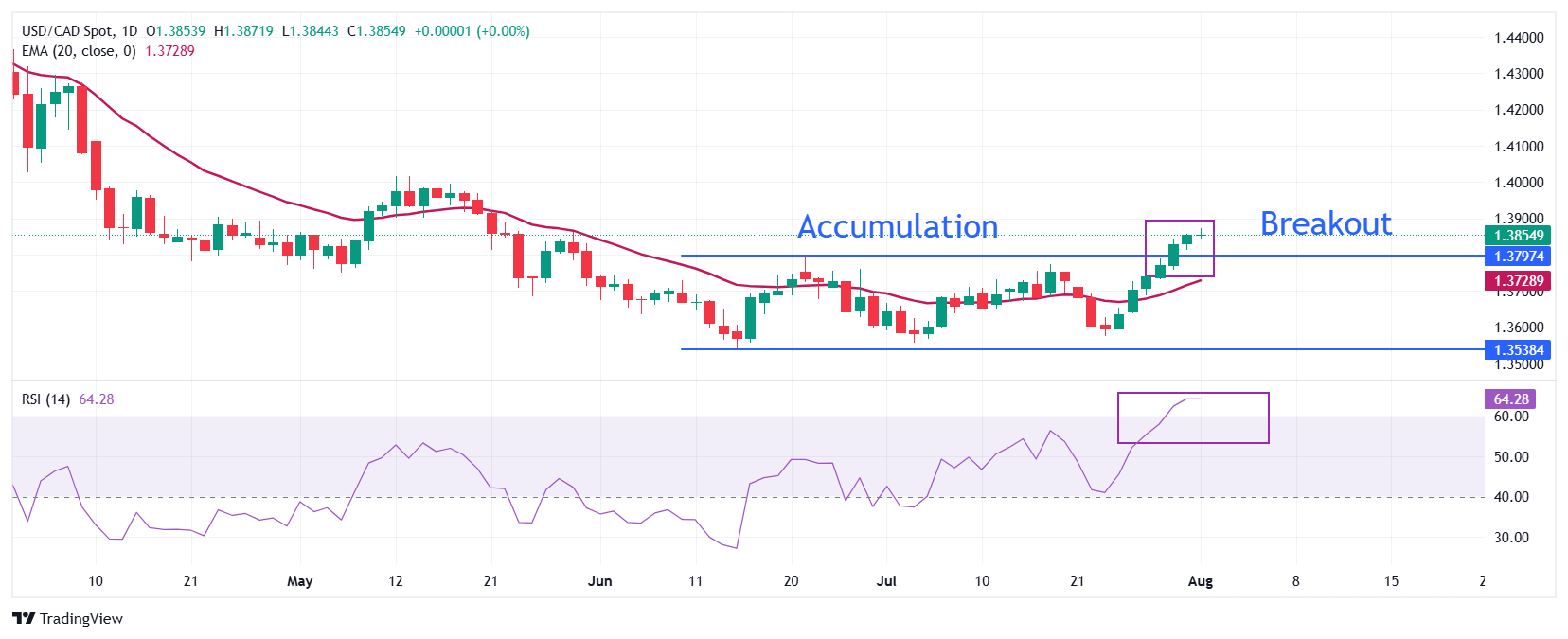USD/CAD Price Forecast: Sees upside to near 1.4000 while Carney criticizes Trump’s tariff raise
- USD/CAD refreshes two-month high near 1.3870 as US President trump raises tariffs on Canada to 35%.
- Canadian PM Carney stated that government is disappointed with the US for raising the tariff rate.
- Investors await the US NFP data for July.
The USD/CAD pair posts a fresh two-month high near 1.3870 on Friday. The Loonie pair strengthens as an increase in the tariff rate announced by United States (US) President Donald Trump on imports from Canada has weakened the Canadian Dollar (CAD).
On Thursday, US President Trump unveiled a list, dictating tariff rates for nations that have failed to reach a deal with Washington during the deadline period. Trump imposed 35% additional duty on imports from Canada, which are higher than 25% stated in the mid of July.
In response, Canadian Prime Minister Mark Carney has said during the late Asian session that the government is disappointed with the US on the fresh tariff rate, while confirming that negotiations with Washington are still going on.
Meanwhile, the US Dollar (USD) trades firmly as traders have pared Federal Reserve’s (Fed) interest rate cut bets for the September policy meeting.
In Friday’s session, investors will focus on the US Nonfarm Payrolls (NFP) data for July, which will be published at 12:30 GMT.
USD/CAD strengthens after a breakout of the Accumulation phase formed in a range between 1.3540 and 1.3800 in past seven weeks, which often leads to a strong bullish trend.
Upward-sloping 20-day Exponential Moving Average (EMA) near 1.3730 suggests that the near-term trend is bullish.
The 14-day Relative Strength Index (RSI) shifts inside the 60.00-80.00 range, indicating a strong bullish momentum.
Going forward, an upside move by the pair above the May 21 high of 1.3920 would open the door towards the May 15 high of 1.4000, followed by the April 9 low of 1.4075.
On the contrary, the asset could slide towards the psychological level of 1.3500 and the September 25 low of 1.3420 if it breaks below the June 16 low of 1.3540.
USD/CAD daily chart

Tariffs FAQs
Tariffs are customs duties levied on certain merchandise imports or a category of products. Tariffs are designed to help local producers and manufacturers be more competitive in the market by providing a price advantage over similar goods that can be imported. Tariffs are widely used as tools of protectionism, along with trade barriers and import quotas.
Although tariffs and taxes both generate government revenue to fund public goods and services, they have several distinctions. Tariffs are prepaid at the port of entry, while taxes are paid at the time of purchase. Taxes are imposed on individual taxpayers and businesses, while tariffs are paid by importers.
There are two schools of thought among economists regarding the usage of tariffs. While some argue that tariffs are necessary to protect domestic industries and address trade imbalances, others see them as a harmful tool that could potentially drive prices higher over the long term and lead to a damaging trade war by encouraging tit-for-tat tariffs.
During the run-up to the presidential election in November 2024, Donald Trump made it clear that he intends to use tariffs to support the US economy and American producers. In 2024, Mexico, China and Canada accounted for 42% of total US imports. In this period, Mexico stood out as the top exporter with $466.6 billion, according to the US Census Bureau. Hence, Trump wants to focus on these three nations when imposing tariffs. He also plans to use the revenue generated through tariffs to lower personal income taxes.
